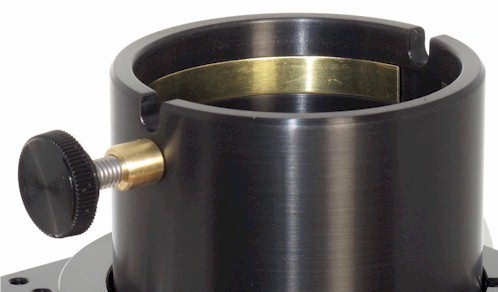
The main setup was:
Conditions were good:
We had a very minor crisis at the Observatory this week: it became impossible to mount an eyepiece adapter or a camera in the 2-inch diameter tube of our electric focuser. The screw which tightens the compression ring inside the tube had slipped out, and couldn't be placed back properly.
Here's an image of a similar focuser from the website of Jim's Mobile, Inc.

Note two features of this picture:
Our problems were caused by two small mis-adjustments: we did not arrange the ring so that the gap was opposite to the screw, and we had the sleeve in the wrong position on the screw.
So, this afternoon, I gently slid the ring around within the tube until the gap was opposite to the screw. One problem down, one to go.
Next, I looked carefully at the screw:
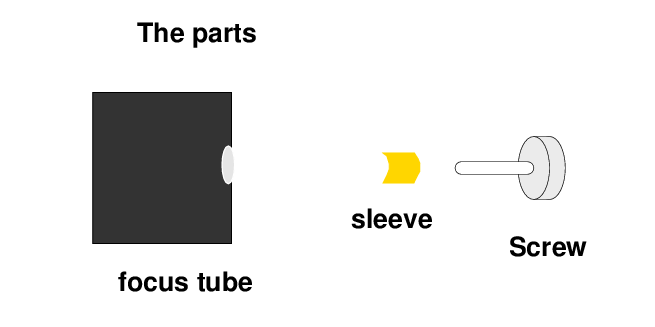
In our case, the yellowish sleeve was pressed up against the black knob.
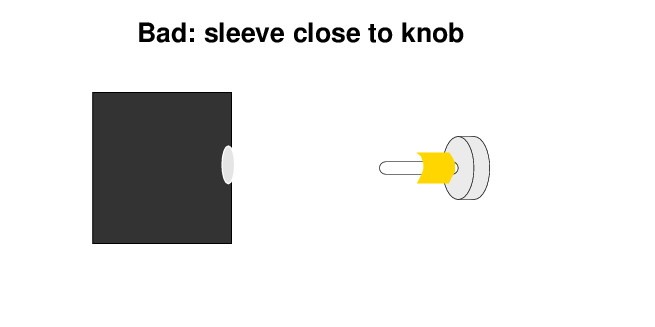
In this position, if one inserts the screw into its hole, only the narrow, silver portion of the screw will go in. The yellow sleeve will remain a short distance away from the focus tube.
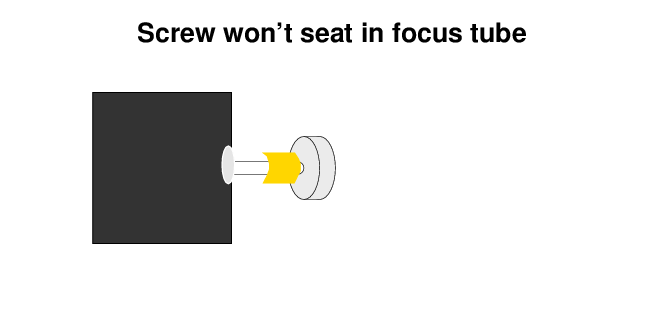
The sleeve was rather tightly set in its place, so I had to use a pair of pliers gently to loosen it. Once it was loose, I moved it to the distal end of the screw.

I was then able to screw the SLEEVE into the threads of the hole in the focus knob. With the SLEEVE firmly attached to the focus knob, turning the knob allows one to make the silver screw move in and out of the hole, tightening and loosening the ring.
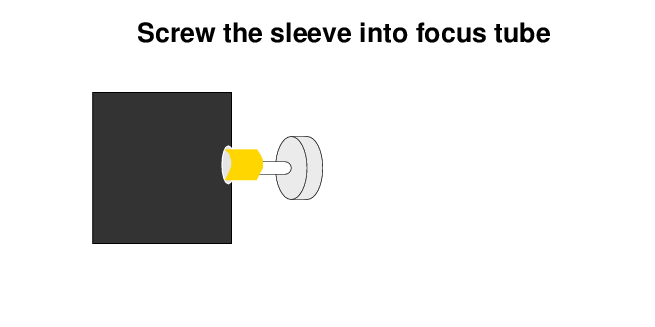
Thanks to the School of Physics and Astronomy at RIT, we acquired a new guide camera: a Orion StarShoot AutoGuider Pro Mono. On this evening, I tried for the first time to attach this camera to our off-axis guide system, and use it from within MaximDL, which we use to control our main CCD camera.
Our ATIK off-axis guider has T-mount threads around the off-axis guider port. I used a Orion Variable Universal Camera Adapter to connect the StarShoot Pro camera to this port. It is necessary to remove the small nosepiece (seen at the bottom of the photo on Orion's catalog) from the adapter, then insert the camera as far as possible, and lock it into place with the lockscrew. Then one can screw the adapter onto the off-axis guider unit.
It took me several hours to realize that the camera can be rotated freely within this adapter. The early test data described below was taken with the rows and columns of the guide camera angled at roughly 40 degrees to North and East; eventually, I did rotate the guide camera to align the rows and columns with the cardinal directions.
To connect the guide camera to the computer,
I installed all the necessary drivers for camera, and updated our ASCOM Platform to version 6.3.
I also installed the latest version of PHD guiding, version 1.14.2, to test the camera. To select the camera from PHD Guiding (or from MaximDL), choose "ASCOM camera", and then from a pull-down list, select "CMOS SSAGPro Camera".
To set up guiding with MaximDL, one must enter a number of parameters. In theory, one can ask MaximDL to calibrate the guider, but our 12-inch Meade LX200 suffers from backlash in the Dec gear, which causes the auto-calibration procedure to fail. After some experimentation, I settled on the following settings: they aren't perfect, but they are a start.
Manual Calib
In order for the guiding to work with these settings, one MUST prepare by doing the following with the LX200 handpaddle: set slew speed to 1 = Guide. This setting of the telescope control system acts as a sort of multiplier to the corrections sent by MaximDL to the mount. If one forgets to set this slew speed to 1, leaving it at a more ordinary value of 3 = 8x or 4 = 16x, then the guiding corrections will be gigantic and cause MaximDL to lose the guide star instantly.
I'm not sure about the XSpeed and YSpeed values. It appears that the telescope is overcorrecting the RA motion, even with the aggressiveness set to its minimum value of 1: the guide star often bounces back and forth across the middle of the guide box. I tried increasing the XSpeed and YSpeed values to 50 and 90, but that did not cause the corrections to shrink. Hmmm. I tried to decrease the minimum guiding movement by setting the "MinMoveX" value to something below 0.01 seconds (the default minimum value), but any smaller value is rounded back up to this value by MaximDL.
I need to investigate the guiding further. Perhaps there is a different protocol which will allow us to make smaller corrections ...
As a test of the autoguider, I took a series of images of the cataclysmic variable star PX And over about 2.2 hours. The target rose from (alt=57, az=109) in the East to nearly the meridian (alt=73, az=173) during the observations. The first 10 images had 30-second exposure times, but all subsequent images had 60 second exposures. All guide camera integration times were 7 seconds. The figure below shows the drift of the field over the course of observations.
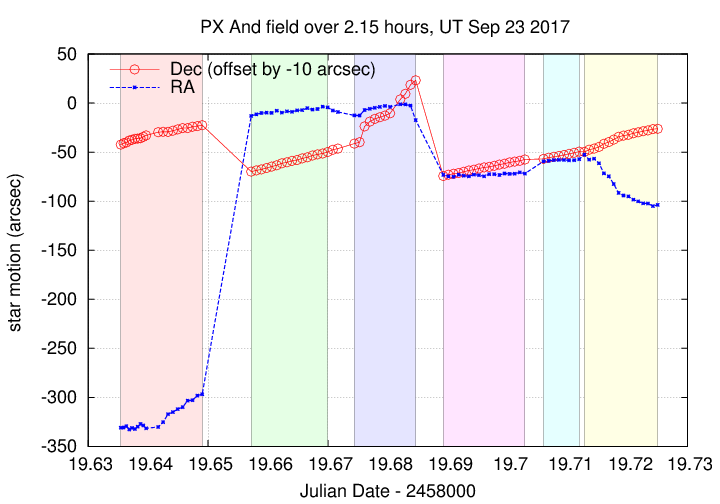
The segments (indicated by colored backgrounds) are from left to right:
guide camera oriented with tilted (row,col) relative to (North, East)
guide camera rotated so (row,col) roughly aligned with (North, East). Also, telescope nudged in Dec slightly North, to try to remove backlash
It is apparent that the guider's signals in the Declination direction are not being carried out properly. I suspect that the backlash in the Dec gear is preventing the small Dec correction signals from actually moving the telescope.
The telescope appears to keep itself in one location over periods of minutes in Right Ascension (good); but, as mentioned earlier, the current system overshoots the RA corrections, causing stars to bounce back and forth in East and West, leading to an elongated PSF.
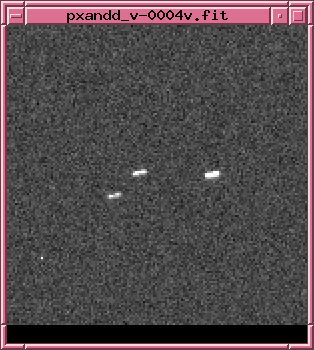
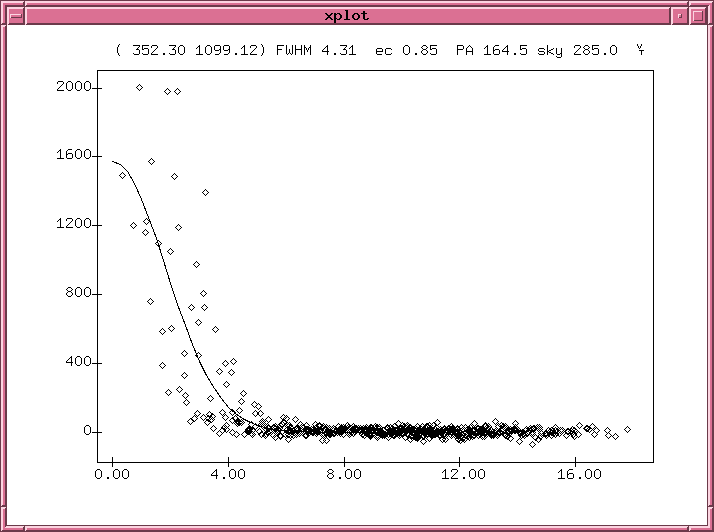
The cataclysmic variable star PX And is currently a target of the Center for Backyard Astrophysics. My main goal this evening was to test the new guide camera, but I decided to point the telescope at this star during my tests.
PX And is at
PX And RA = 00 30 05.81 Dec = +26 17 26.4
A subsection of one of the 60-second V-band images is shown below: the field of view is roughly 22 by 17 arcminutes; North up, East to the left.
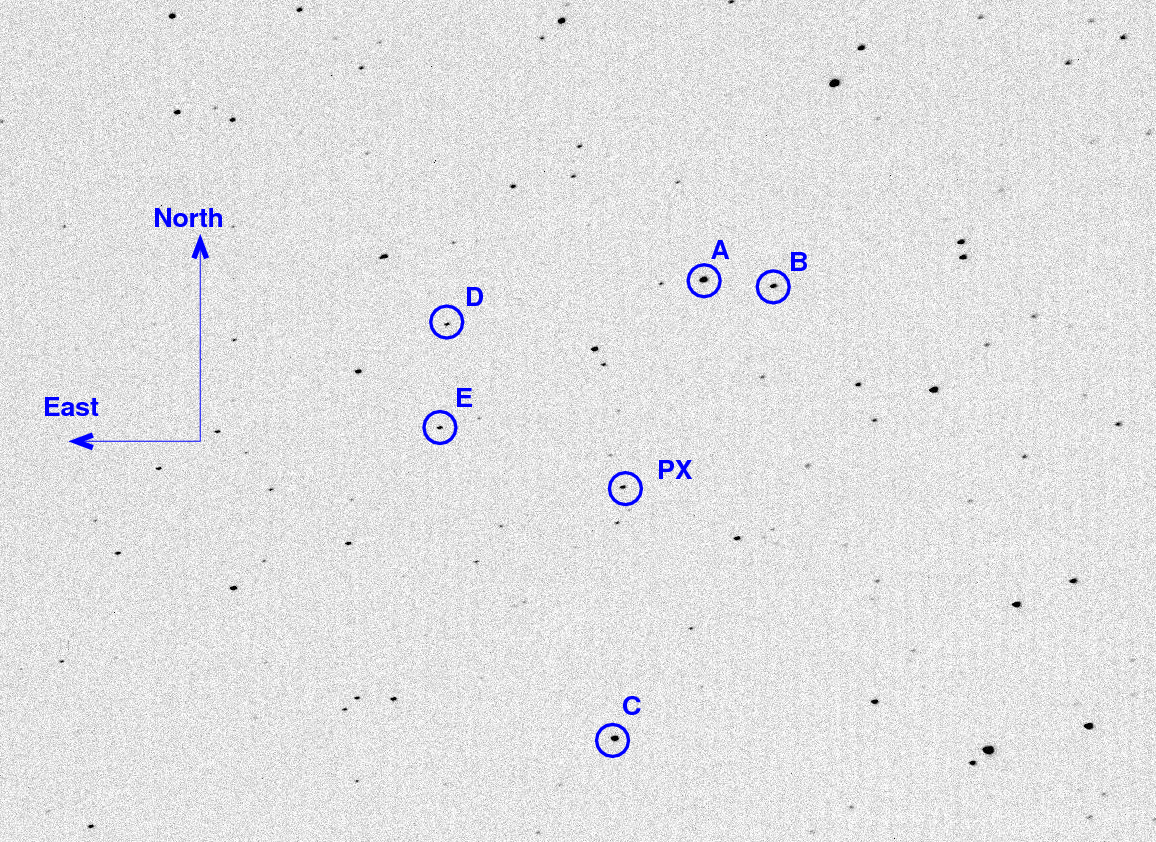
Entries for some of the marked comparison stars from the UCAC4 follow:
star UCAC4 B V ---------------------------------------------------- A 582-001238 13.414 12.858 ----------------------------------------------------
I used 30-second exposures with V-band filter for the first 10 images, then switched to 60-second V-band images for the rest of the measurements.
Because I was testing the guider throughout these observations, the stars drifted across the chip. Some of the scatter in the final measurements must be due to variations as sources moved from one region to another.
Using aperture photometry with a radius of 5 pixels (radius of 6.7 arcsec), I measured the instrumental magnitudes of a number of reference stars and the target. Following the procedures outlined by Kent Honeycutt's article on inhomogeneous ensemble photometry, I used all stars available in each image to define a reference frame, and measured each star against this frame.
Sigma-vs-mag plots show that the floor was about 0.006 mag. PX And is the outlier at diff mag = 5.2.
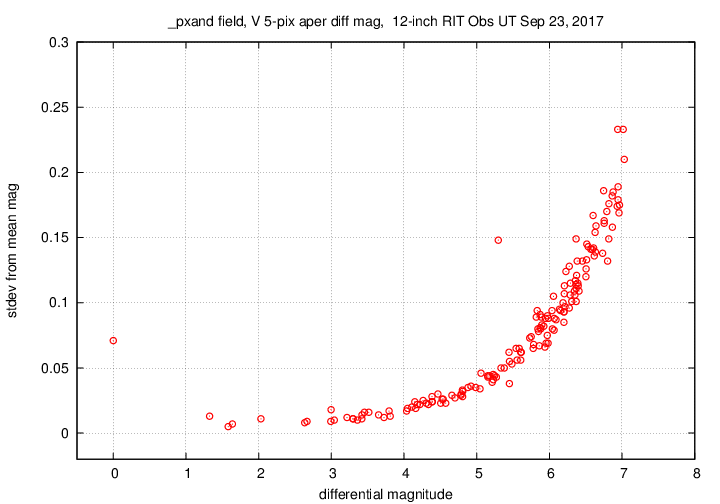
Image adjustment factor shows a clump of elevated points at the start; those are the 30-second measurements. Other than that, there is no evidence for clouds, just lots of outliers due to trailed images.
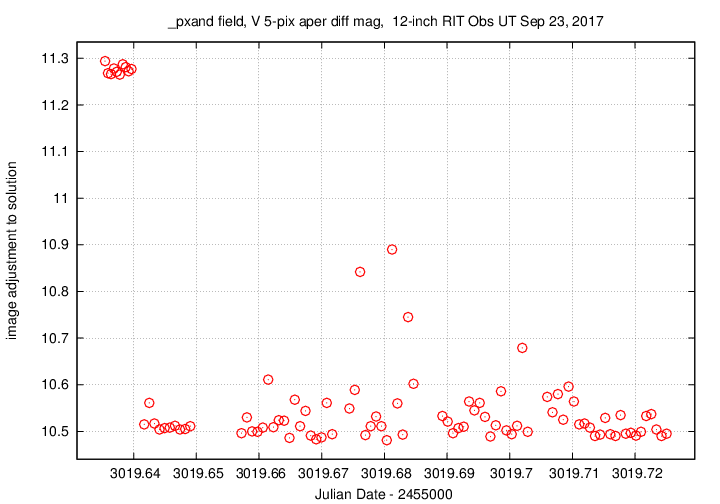
Here are light curves of the variable and the field stars:
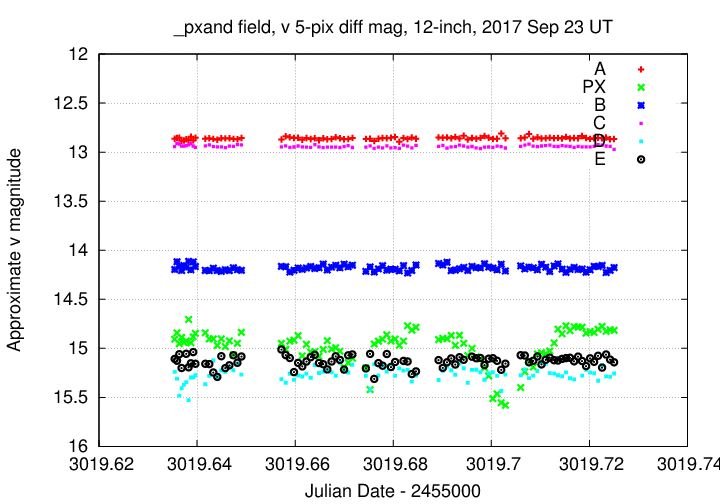
I used the UCAC value for the V-band magnitude of star "A" = UCAC4 582-001238 to shift the ensemble magnitudes to the standard V-band scale. You can download my measurements below. A copy of the header of the file is shown to explain the format.
# Measurements of PX_And made at RIT Obs, Sep 23, 2017 UT, # in good conditions, # by Michael Richmond, # using Meade 12-inch LX200 and ATIK 11000. # Exposures 30 or 60 seconds long, V filter. # Tabulated times are midexposure (FITS header time - half exposure length) # and accurate only to +/- 1 second (??). # 'mag' is a differential magnitude based on ensemble photometry # using a circular aperture of radius 5 pix = 6.7 arcseconds. # which has been shifted so UCAC4 582-001238 has mag=12.858 # which is its V-band magnitude according to UCAC4. # # UT_day JD HJD mag uncert Sep23.13544 2458019.63544 2458019.64059 14.907 0.045 Sep23.13591 2458019.63591 2458019.64106 14.843 0.044 Sep23.13638 2458019.63638 2458019.64153 14.953 0.050
Last modified 9/23/2017 by MWR.